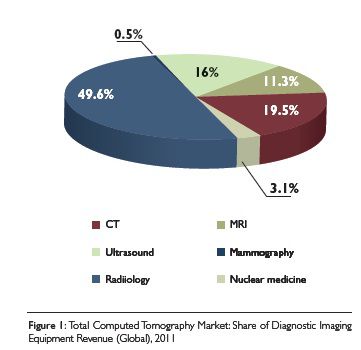HealthManagement, Volume 12 - Issue 4, 2012
The Future of Prognosis
The Computed Tomography (CT) equipment industry the second largest of the diagnostic medical imaging market. CT equipment stationed at hospitals and imaging centres caters to numerous clinical applications such as cardiology, oncology, neurology and musculoskeletal applications. It detects infarctions, tumours, trauma and calcifications. The CT market is a diverse one with various product types of different specifications, catering to a wide array of needs and demands. Increased prevalence and awareness of diseases like cancer and coronary artery disease has contributed to market growth.

Rapid Technical Change
The market is volatile in terms of technical change. There are a number of new products being introduced in the market regularly. These products have superior features in terms of reduced scanning times, lower dosage levels and fine image quality. In years to come, numerous premium and super premium CT systems will be flooding the market, thereby sparking demand for high slice CT systems. Single and dual slice CT systems will become obsolete and they will be replaced by these high slice CT systems. This is an important factor that will drive market growth for the entire term of the forecast period.
The capability of CT to integrate into an existing workflow process is a major advantage, which helps in its market penetration. Digitisation and transition to electronic health records require a workflow process that is efficient and fully automated.
Non-Invasive Procedures
Rapid advances in imaging technologies have led to increasing number of diagnostic procedures becoming non-invasive. There is a shift of preference to non-invasive diagnostic methods. For example, cardiac computed tomography angiography is now a preferred screening method that has replaced traditional coronary angiography due to the side effects of the invasive method.
Barriers to Growth
Competition from MRI and other imaging modalities will affect CT’s growth. CT’s potential growth requires validation of its claimed diagnostic efficiency. Moreover, dose reduction strategies will have to be tested and proved to be effective in achieving their goal. More white papers and publications that prove the robustness of the modality in accurate diagnosis and successful implementation of the various dose reduction techniques on a large scale need to be in place for CT to have a competitive hold on the market. Lack of these features will lead to preference for other imaging modalities over CT. Proven invasive diagnostic methods may also be chosen by physicians and patients to avoid risk.
The CT Market
The CT market is highly price sensitive. The market is strictly regulated by the degree of technical change and pricing parameters. The unit shipment of the CT market has been increasing continuously for the past few years. The high demand rate for new CT equipment due to increasing awareness among physicians and patients is the reason for the constant increase in the number of installed bases across Europe. This is expected to grow with the introduction of technologically superior variants in the coming years. The market is highly concentrated with a limited number of market participants.
The European CT market was calculated to have revenue of US$532.6 million in 2011. 2012-2013 will witness increased growth rate. This is due to the fact that more than 65 percent of the installed CT systems in Europe are older than ten years. This favourable replacement cycle contributes to increased market revenues.
Cardiac imaging is shaping up to be the major clinical application that CT caters to, and a 16 slice CT system is considered necessary for the same.
Hence, single and dual scanners will soon become obsolete. Advanced clinical applications such as neuro imaging require a premium or super premium CT scanner for effective prognosis. This, along with price optimisation of the high slice scanners, will result in the growth of that segment.
Growth of Higher Slice CT Scanners
Germany, Italy and the United Kingdom will contribute to the market revenue of CT in the coming years, as a major portion of the installed base in these countries is more than 8 years old. They can be expected to contribute to the growth of 64 slice CT scanners. The growth of higher slice CT scanners will be primarily due to Scandinavia and the Benelux countries that are considered to be technology adopters.


















